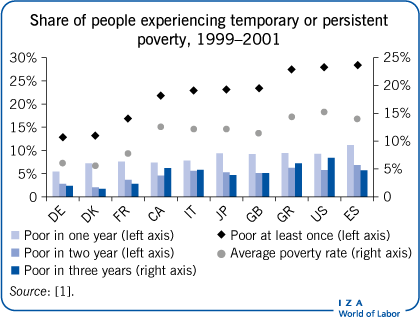Elevator pitch
A considerable part of the poverty that is measured in a single period is transitory rather than persistent. In most countries, only a portion of people who are currently poor are persistently poor. People who are persistently poor or who cycle into and out of poverty should be the main focus of anti-poverty policies. Understanding the characteristics of the persistently poor, and the circumstances and mechanisms associated with entry into and exit from poverty, can help to inform governments about options to reduce persistent poverty. Differences in poverty persistence across countries can shed additional light on possible sources of poverty persistence.
Key findings
Pros
A considerable part of poverty measured in a single period is transitory rather than persistent.
Distinguishing between temporary and persistent poverty is important as economic policy should focus on preventing persistent poverty.
Understanding characteristics of the persistently poor and events associated with entry and exit into poverty are important for informing anti-poverty policies.
The characteristics of the persistently poor are often different from those of the currently poor.
It is relevant for economic policy to know whether poverty persistence is due to individual characteristics or to poverty-trap mechanisms (being poor today increases the risk of being poor in the future).
Cons
How to weight aspects of poverty persistence such as duration, intensity, and recurrence is unclear.
It is difficult econometrically to separate poverty persistence due to individual characteristics from that due to poverty-trap mechanisms.
Identifying events associated with poverty entry and exit can inform policies, but a large share of entries and exits cannot be clearly characterized in terms of individual events.
There are common factors in poverty persistence across countries but also several differences.
The evidence is mixed on whether incentive problems such as welfare dependency increase the poverty trap effects that can lead to persistent poverty.
